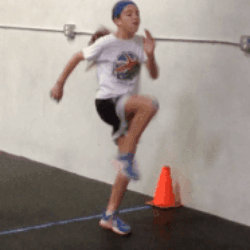3 benefits of resistance training for youth athletes
By: Rogel Lima
Increase in Athletic Performance
Resistance training has been scientifically proven to help youth athletes increase their level of performance in their respective sports. Studies show that youth athletes that participate in long term resistance based training programs have seen improvements in their overall muscular strength, speed, power, motor skill development, and body control (Stricker et al 2020). To go further in depth Granacher et al (2016) published a review looking into the relationship between resistance training and athletic performance. Regarding youth athletes, in their research they found that a long term based training programs focused around complex training, the implementation of both resistance training and plyometrics, yielded the best results among different sports. Some of the sports mentioned in the study were soccer, baseball, and tennis.
Injury Prevention
With the steadily increasing demand of youth sports it is important to make sure that the athletes can stay on the field. Overuse injuries are becoming more common and a great way to combat that is resistance training. By focusing on the areas that are constantly being used, for example the shoulder of a baseball player, you can decrease the likelihood of an injury there by strengthening the muscles around the shoulder joint (Stricker et al 2020). Legerlotz et al (2016) did a review on the physiological adaptation of resistance training on young athletes and they found that resistance training lessens the imbalances between muscles and tendons to increase stability in those joints. On top of that, resistance training lessens the chance of bone breaks by increasing bone mass and/or density. There was a study reviewed that showed an increase in bone content that was correlated to four or more hours of resistance training a week in youth soccer athletes (Legerlotz et al 2016).
Healthier Lifestyle
Resistance training can also be seen as a gateway to get children and adolescents active overall. Regardless if they play a sport or not it is important that children and adolescents to participate in physical activity to maintain healthy living habits. The CDC (2022) recommends that this population participate in at 60 minutes of moderate to vigorous physical activity every day. Withing those guidelines it is also suggested that they perform muscle strengthening and bone strengthening exercise at least 3 times a week. As mentioned early, resistance training is a viable option to get both of those types of exercise done at the same time. Therefore, incorporating resistance training in to a child’s weekly routine can help them establish a healthy lifestyle.
Granacher, U., Lesinski, M., Büsch, D., Muehlbauer, T., Prieske, O., Puta, C., Gollhofer, A., & Behm, D. G. (2016). Effects of Resistance Training in Youth Athletes on Muscular Fitness and Athletic Performance: A Conceptual Model for Long-Term Athlete Development. Frontiers in Physiology, 7. https://doi.org/10.3389/fphys.2016.00164
Legerlotz, K., Marzilger, R., Bohm, S., & Arampatzis, A. (2016). Physiological Adaptations following Resistance Training in Youth Athletes—A Narrative Review. Pediatric Exercise Science, 28. https://doi.org/10.1123/pes.2016-0023
Stricker, P. R., Faigenbaum, A. D., McCambridge, T. M., COUNCIL ON SPORTS MEDICINE AND FITNESS, LaBella, C. R., Brooks, M. A., Canty, G., Diamond, A. B., Hennrikus, W., Logan, K., Moffatt, K., Nemeth, B. A., Pengel, K. B., & Peterson, A. R. (2020). Resistance Training for Children and Adolescents. Pediatrics, 145(6), e20201011. https://doi.org/10.1542/peds.2020-1011
Youth Physical Activity Guidelines | Physical Activity | Healthy Schools | CDC. (2022, August 11). https://www.cdc.gov/healthyschools/physicalactivity/guidelines.htm


